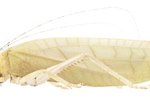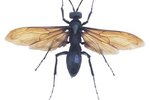
Walking sticks are order Phasmida insects with lengthy, super-narrow physiques. They're also frequently known as stick insects. The world of walking sticks features an abundance of useful physical adaptations that help keep them out of harm's way.
Environmental Coloration
Many walking sticks are fortunate enough to have the same coloration as their environments. These colors typically are vivid greens and deep browns -- good matches for their favored forest habitats. Some walking sticks, however, are blue; some are black.
A Lot Like Sticks
Walking sticks are adept at confusing predators into thinking they're sticks rather than prey. These insects are proficient not just at remaining still but at swinging their bodies back and forth to mimic tree shoots moving in a breeze. It's rare for animals to feed on sticks, so this unique adaptation is an effective one.
Unpleasant Odors and Tastes
Some types of walking sticks manage risks of predation by giving off aggressively unpleasant odors that drive their enemies away. Giant spiny stick insects (Eurycantha calcarata) and southern two-striped walking sticks (Anisomorpha buprestoides) are just two examples of walking sticks with these types of odoriferous protective adaptations. Walking sticks frequently emit markedly bad-tasting fluids as a means of discouraging predators.
Wing Confusion
Some walking sticks are equipped with striking wings that function as defensive physical adaptations. If these walking sticks encounter predators, they can prominently put their wings out for show and then instantly fall down only to tuck the wings away again, making them essentially invisible. This baffles predators.
Spiky Defense
Walking sticks sometimes possess spikes over their back legs. If a predator is about to devour a walking stick, the walking stick can drive the nuisance away by striking with his legs. This adaptation is exclusive to some bigger varieties of walking sticks.
Stiff Bodies
Walking sticks seized by predators often instantly turn stiff and tense to the touch. This is meant to fool predators into thinking they're twigs and therefore of no interest. Although this adaptation often is effective, it sometimes can backfire on the sluggish creatures -- some animals are willing to eat sticks, after all.
Youngsters
One fascinating physical adaptation that exists in some walking stick youngsters is referred to as autonomy. If a predator seizes a youngster's limb, the juvenile can respond by letting the leg go. Thankfully, the little critter can can grow a brand new replacement limb within a span of roughly two weeks.
References
- National Geographic: Stick Insect
- Blank Park Zoo: Walking Stick
- Cosley Zoo: Common Walking Stick
- Oakland Zoo: Giant Thorny Walking Stick
- San Diego Zoo Animals: Stick Insect
- Arizona-Sonora Desert Museum: Walkingsticks
- Australian Museum: Care of Stick Insects
- Texas A&M AgriLife Extension: Walkingstick
Photo Credits
-
Zedcor Wholly Owned/PhotoObjects.net/Getty Images




